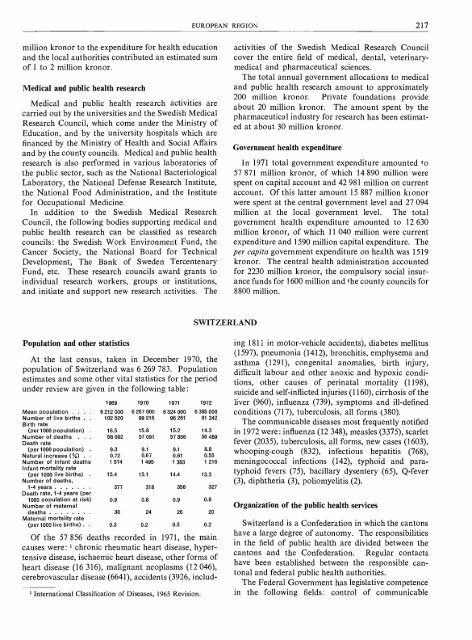FIFTH REPORT - World Health Organization
FIFTH REPORT - World Health Organization
FIFTH REPORT - World Health Organization
Create successful ePaper yourself
Turn your PDF publications into a flip-book with our unique Google optimized e-Paper software.
EUROPEAN REGION 217<br />
million kronor to the expenditure for health education<br />
and the local authorities contributed an estimated sum<br />
of 1 to 2 million kronor.<br />
Medical and public health research<br />
Medical and public health research activities are<br />
carried out by the universities and the Swedish Medical<br />
Research Council, which come under the Ministry of<br />
Education, and by the university hospitals which are<br />
financed by the Ministry of <strong>Health</strong> and Social Affairs<br />
and by the county councils. Medical and public health<br />
research is also performed in various laboratories of<br />
the public sector, such as the National Bacteriological<br />
Laboratory, the National Defense Research Institute,<br />
the National Food Administration, and the Institute<br />
for Occupational Medicine.<br />
In addition to the Swedish Medical Research<br />
Council, the following bodies supporting medical and<br />
public health research can be classified as research<br />
councils: the Swedish Work Environment Fund, the<br />
Cancer Society, the National Board for Technical<br />
Development, The Bank of Sweden Tercentenary<br />
Fund, etc. These research councils award grants to<br />
individual research workers, groups or institutions,<br />
and initiate and support new research activities. The<br />
activities of the Swedish Medical Research Council<br />
cover the entire field of medical, dental, veterinary -<br />
medical and pharmaceutical sciences.<br />
The total annual government allocations to medical<br />
and public health research amount to approximately<br />
200 million kronor. Private foundations provide<br />
about 20 million honor. The amount spent by the<br />
pharmaceutical industry for research has been estimated<br />
at about 30 million kronor.<br />
Government health expenditure<br />
In 1971 total government expenditure amounted to<br />
57 871 million kronor, of which 14 890 million were<br />
spent on capital account and 42 981 million on current<br />
account. Of this latter amount 15 887 million kronor<br />
were spent at the central government level and 27 094<br />
million at the local government level. The total<br />
government health expenditure amounted to 12 630<br />
million kronor, of which 11 040 million were current<br />
expenditure and 1590 million capital expenditure. The<br />
per capita government expenditure on health was 1519<br />
kronor. The central health administration accounted<br />
for 2230 million kronor, the compulsory social insurance<br />
funds for 1600 million and the county councils for<br />
8800 million.<br />
SWITZERLAND<br />
Population and other statistics<br />
At the last census, taken in December 1970, the<br />
population of Switzerland was 6 269 783. Population<br />
estimates and some other vital statistics for the period<br />
under review are given in the following table:<br />
Mean population . . .<br />
Number of live births . .<br />
Birth rate<br />
(per 1000 population) .<br />
Number of deaths . . .<br />
Death rate<br />
(per 1000 population) .<br />
Natural increase (%)<br />
Number of infant deaths<br />
Infant mortality rate<br />
(per 1000 live births) .<br />
Number of deaths,<br />
1 -4 years<br />
Death rate, 1 -4 years (per<br />
1000 population at risk)<br />
Number of maternal<br />
deaths<br />
Maternal mortality rate<br />
(per 1000 live births) . .<br />
1969<br />
6 212 000<br />
102 520<br />
16.5<br />
58 002<br />
9.3<br />
0.72<br />
1 574<br />
15.4<br />
0.9<br />
0.3<br />
377<br />
30<br />
6<br />
1970<br />
267 000 6<br />
99 216<br />
15.8<br />
57 091<br />
9.1<br />
0.67<br />
1 495<br />
15.1<br />
0.8<br />
0.2<br />
318<br />
24<br />
1971<br />
324 000<br />
96 261<br />
15.2<br />
57 856<br />
9.1<br />
0.61<br />
1 383<br />
14.4<br />
0.9<br />
0.3<br />
356<br />
26<br />
6<br />
1972<br />
385 000<br />
91 342<br />
14.3<br />
56 489<br />
8.8<br />
0.55<br />
1 216<br />
Of the 57 856 deaths recorded in 1971, the main<br />
causes were: 1 chronic rheumatic heart disease, hypertensive<br />
disease, ischaemic heart disease, other forms of<br />
heart disease (16 316), malignant neoplasms (12 046),<br />
cerebrovascular disease (6641), accidents (3926, includ-<br />
1 International Classification of Diseases, 1965 Revision.<br />
13.3<br />
0.8<br />
327<br />
20<br />
0.2<br />
ing 1811 in motor -vehicle accidents), diabetes mellitus<br />
(1597), pneumonia (1412), bronchitis, emphysema and<br />
asthma (1291), congenital anomalies, birth injury,<br />
difficult labour and other anoxic and hypoxic conditions,<br />
other causes of perinatal mortality (1198),<br />
suicide and self -inflicted injuries (1160), cirrhosis of the<br />
liver (960), influenza (739), symptoms and ill- defined<br />
conditions (717), tuberculosis, all forms (380).<br />
The communicable diseases most frequently notified<br />
in 1972 were: influenza (12 348), measles (3375), scarlet<br />
fever (2035), tuberculosis, all forms, new cases (1603),<br />
whooping -cough (832), infectious hepatitis (768),<br />
meningococcal infections (142), typhoid and paratyphoid<br />
fevers (75), bacillary dysentery (65), Q -fever<br />
(3), diphtheria (3), poliomyelitis (2).<br />
<strong>Organization</strong> of the public health services<br />
Switzerland is a Confederation in which the cantons<br />
have a large degree of autonomy. The responsibilities<br />
in the field of public health are divided between the<br />
cantons and the Confederation. Regular contacts<br />
have been established between the responsible cantonal<br />
and federal public health authorities.<br />
The Federal Government has legislative competence<br />
in the following fields : control of communicable
















